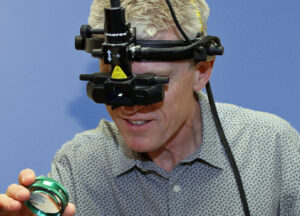St John of God Eye Clinic is a subspecialty eye clinic with a focus on retinal conditions, cataract surgery, lid & oculoplastic surgery and pterygium surgery, but we see patients with a wide range of eye conditions.
We welcome referrals for the following conditions:
Cataract & Lens problems
Macular degeneration & macular disorders
Eyelid disorders and oculoplastic surgery
Disorders of Retina & Vitreous
Corneal Problems
General Ophthalmology and Common Eye Problems
Symptoms that may indicate a Serious and/or Urgent threat to sight

Treatments performed in Clinic:
Intravitreal Drug Therapy (Eye injections)
Many conditions affecting the retina and macula of the eye are now managed with drug injections into the eye. We use multiple agents, including Eylea (aflibercept), Lucentis (ranibizumab), Avastin (bevacizumab), triamcinolone and Ozurdex (slow-release dexamethasone), methotrexate, and various antibiotic and anti-viral drugs. Intravitreal drug therapy has become particularly important in the management of wet macular degeneration, diabetic retinopathy (diabetic macular oedema) and retinal vein occlusion.
The eye is numbed with anaesthetic drops and an anaesthetic injection may be given on the surface of the eye. The eye is prepared with Betadine or Chlorhexidine antiseptic solution and a tiny volume (0.05 to 0.1ml) or a tiny pellet, depending on the drug, is then given via a short, very fine needle through the white of the eye (conjunctiva and sclera) into the middle of the eyeball (the vitreous cavity). There is generally minimal or no discomfort at the time of injection. An eye pad is applied and this can be removed after one hour. The eye may feel a bit gritty until the following day and redness or blood on the white of the eye is common, but not a concern. Artificial tears may be used as frequently as desired to soothe any gritty sensation in the eye. The process might sound scary, but the injection tends to be a big anti-climax for those patients having their first treatment and the whole process tends to be very well tolerated.
Retinal and Macular Laser treatment
While intravitreal drug therapy has reduced the necessity for laser treatment for macular oedema (swelling of the central retina) in several conditions like diabetic retinopathy and retinal vein occlusion, laser continues to play an important role in the management of retinal and macular disorders. Retinal laser treatment is delivered in our clinic on an outpatient basis. We have both slit lamp delivery systems, for which the patient sits upright in a chair for treatment, and a laser indirect ophthalmoscopy system, in which a special, automated, reclining chair is used to lie the patient flat for treatment.

YAG Laser (Neodymium-doped yttrium aluminium garnet laser)
YAG laser is most commonly used to clear a hazy film of protein deposit that gradually builds up on the back surface of the artificial lens that is implanted in the eye during cataract surgery. A considerable proportion of patients undergoing cataract surgery will eventually develop this deposit, impairing the clarity of vision. Called “YAG laser posterior capsulotomy,” this type of treatment is totally painless, works almost immediately, and rarely needs to be repeated.
YAG laser can also be used for some other purposes, such as peripheral iridotomy, which can be used if there is a risk of pupil-block, angle closure glaucoma.
SLT Laser (Selective Laser Trabeculoplasty)
SLT Laser is used as a treatment for ocular hypertension and glaucoma to lower eye pressure.
Minor Lid procedures
Removal of chalazia (meibomian cysts) and biopsies of some lid lesions may be performed in the clinic. More major lid surgery is performed in the operating theater.
YAG Laser for Floaters
We also have a special YAG laser that is specifically designed to treat vitreous floaters. This is treatment is known as “YAG laser vitreolysis.” Only certain types of floaters are suited to this form of treatment.
Photodynamic Therapy (PDT)
PDT is a special laser-activated drug treatment that was originally developed for wet macular degeneration, but which can be also used to treat several other eye diseases such as central serous chorioretinopathy, polypoidal choroidal vasculopathy, and choroidal haemangioma.
PDT is a two step procedure that firstly involves an intravenous infusion of green-coloured Visudyne drug through a vein in the arm. The Visudyne drug circulates around the whole body in the bloodstream, but is specifically absorbed by abnormal blood vessels in the eye. The Visudyne drug doesn’t actually do anything until it is activated by treating the eye with a special “cold” laser. Once a timed period of usually 15 minutes has elapsed from the moment that the Visudyne intravenous infusion was started, a contact lens is placed on the eye and the special laser is applied. The laser causes the Visudyne drug that has been absorbed by the eye to disintegrate into active chemicals. The chemicals produced by PDT specifically and selectively damage or stimulate healing in the leaking blood vessels at the back of the eye. Ideally, PDT causes these blood vessels to stop leaking, thereby putting an end to progressive damage to the central vision. Although the treatment has been around for well over 20 years, the ability to perform PDT in Australia has been hampered by a number of factors, including problems relating to the manufacture and supply of the Visudyne drug, the designation of the treatment as “experimental” by the Therapeutic Goods Administration of Australia (TGA), the exclusion of most treatments from Medicare rebates, and the consequent significant cost of the treatment.
Investigations performed in Clinic:
- Acuity & Eye Pressure
- Colour Vision
- Visual Field Testing (Automated perimetry)
- OCT (Optical Coherence Tomography)
- Pachymetry
- Corneal Topography and Wavefront Aberrometry
- Ocular Biometry (Laser Interferometric Biometry)
- Ocular Ultrasound
- Ultra-Widefield Optos Fundus Imaging
- Fundus Autofluorescence
- Fluorescein Angiography
- Indocyanine Green (ICG) Angiography
- Biopsy of skin and lid lesions

Surgery:
More complicated surgical procedures are performed in day surgery or
hospital
